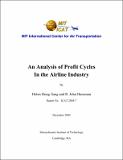An Analysis of Profit Cycles In the Airline Industry
Author(s)
Jiang, Helen Hong; Hansman, R. John
DownloadICAT_rpt_Helen-thesis.pdf (1.086Mb)
Metadata
Show full item recordAbstract
The objective of this paper is to understand the financial dynamics of the airline industry by identifying profit cycle periods of the industry and their driving factors. Assuming that the industry profit cycles could be modeled as an undamped second-order system, the fundamental cycle period was identified to be 11.3 years for the U.S. airlines and 10.5 years for the world airlines. Analyses of industry profits reveal that such cycle period is endogenous, neither deregulation nor September 11 have significantly changed it. Parametric models were developed under the hypothesis that phase lag in the system caused profit oscillations; and two hypotheses, lag in capacity response and lag in cost adjustment were studied. A parametric model was developed by hypothesizing the delay in capacity response caused profit oscillations. For this model, the system stability depends on the delay between aircraft orders and deliveries and the aggressiveness in airplane ordering. Assuming industry profits correlated to capacity shortfall, the delay and gain were calculated and the results were consistent with the observed delay between world aircraft deliveries and net profits. Since the gain in the model has lumped impacts of exogenous factors, exaggerated capacity response was observed in simulation. This indicates capacity shortfall alone cannot fully explain the industry dynamics. The model also indicates reduced delay may help to mitigate system oscillations. Similarly, a parametric model was developed by hypothesizing the delay in cost adjustment caused profit oscillations, and simulation results were consistent with industry profits. A coupled model was developed to study the joint effects of capacity and cost. Simulations indicated that the coupled model explained industry dynamics better than the individual capacity or cost models, indicating that the system behavior is driven by the joint effects of capacity response and cost adjustment. A more sophisticated model including load factor and short-term capacity effects is proposed for future work in an effort to better understand the industry dynamics. This document is based on the thesis of Helen Hong Jiang submitted to the Department
Date issued
2004-12Series/Report no.
ICAT-2004-7
Keywords
airline industry, financial dynamics, profit cycle, air transportation